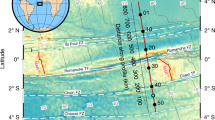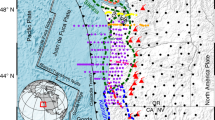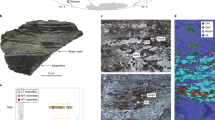Abstract
Water and carbon are transferred from the ocean to the mantle in a process that alters mantle peridotite to create serpentinite and supports diverse ecosystems1. Serpentinized mantle rocks are found beneath the sea floor at slow- to ultraslow-spreading mid-ocean ridges1 and are thought to be present at about half the world’s rifted margins2,3. Serpentinite is also inferred to exist in the downgoing plate at subduction zones4, where it may trigger arc magmatism or hydrate the deep Earth. Water is thought to reach the mantle via active faults3,4. Here we show that serpentinization at the rifted continental margin offshore from western Spain was probably initiated when the whole crust cooled to become brittle and deformation was focused along large normal faults. We use seismic tomography to image the three-dimensional distribution of serpentinization in the mantle and find that the local volume of serpentinite beneath thinned, brittle crust is related to the amount of displacement along each fault. This implies that sea water reaches the mantle only when the faults are active. We estimate the fluid flux along the faults and find it is comparable to that inferred for mid-ocean ridge hydrothermal systems. We conclude that brittle processes in the crust may ultimately control the global flux of sea water into the Earth.
This is a preview of subscription content, access via your institution
Access options
Subscribe to this journal
Receive 12 print issues and online access
$259.00 per year
only $21.58 per issue
Buy this article
- Purchase on Springer Link
- Instant access to full article PDF
Prices may be subject to local taxes which are calculated during checkout



Similar content being viewed by others
Change history
26 May 2016
In the version of the Letter originally published, the following reference was mistakenly omitted in the Methods: '29. Minshull, T. A., Sinha, M. C. & Peirce, C. Multi-disciplinary, sub-seabed geophysical imaging. Sea Technol. 46, 27–31 (2005).' This should have been cited after '(OBSs)' in the sentence 'A grid of 72 ocean bottom instruments, comprising 44 four-component ocean bottom seismometers (OBSs) and 28 ocean bottom hydrophones (OBHs) was deployed on the seabed for three months to record these shots, with sample rates of 250 Hz and 200 Hz, respectively'. The original refs 29–33 have been renumbered accordingly. This has been corrected in the online versions of the Letter.
References
Fruh-Green, G. L. et al. Serpentinization of oceanic peridotites: implications for geochemical cycles and biological activity. Subseafloor Biosph. Mid-Ocean Ranges 144, 119–136 (2004).
Whitmarsh, R. B., Manatschal, G. & Minshull, T. A. Evolution of magma-poor continental margins from rifting to seafloor spreading. Nature 413, 150–154 (2001).
Perez-Gussinye, M. & Reston, T. J. Rheological evolution during extension at nonvolcanic rifted margins: onset of serpentinization and development of detachments leading to continental breakup. J. Geophys. Res. 106, 3961–3975 (2001).
Ranero, C. R. et al. Bending-related faulting and mantle serpentinization at the Middle America trench. Nature 425, 367–373 (2003).
Manning, C. E. & Ingebritsen, S. E. Permeability of the continental crust: implications of geothermal data and metamorphic systems. Rev. Geophys. 37, 127–150 (1999).
Sibson, R. H. Fluid involvement in normal faulting. J. Geodynam. 29, 469–499 (2000).
Faulkner, D. R. et al. A review of recent developments concerning the structure, mechanics and fluid flow properties of fault zones. J. Struct. Geol. 32, 1557–1575 (2010).
Reston, T. J. The structure, evolution and symmetry of the magma-poor rifted margins of the North and Central Atlantic: a synthesis. Tectonophysics 468, 6–27 (2009).
O’reilly, B. M. et al. Crustal thinning, mantle exhumation and serpentinization in the Porcupine Basin, offshore Ireland: evidence from wide-angle seismic data. J. Geol. Soc. 163, 775–787 (2006).
Funck, T. et al. Crustal structure of the ocean-continent transition at Flemish Cap: seismic refraction results. J. Geophys. Res. 108, 2531 (2003).
Wu, Y. et al. Crustal structure of the central Nova Scotia margin off eastern Canada. Geophys. J. Int. 166, 878–906 (2006).
Rupke, L. H. et al. Interrelation between rifting, faulting, sedimentation, and mantle serpentinization during continental margin formation-including examples from the Norwegian Sea. Geochem. Geophys. Geosyst. 14, 4351–4369 (2013).
Reston, T. J. et al. Movement along a low-angle normal fault: the S reflector west of Spain. Geochem. Geophys. Geosyst. 8, Q06002 (2007).
Escartin, J., Hirth, G. & Evans, B. Effects of serpentinization on the lithospheric strength and the style of normal faulting at slow-spreading ridges. Earth Planet. Sci. Lett. 151, 181–189 (1997).
Zelt, C. A. et al. Assessment of crustal velocity models using seismic refraction and reflection tomography. Geophys. J. Int. 153, 609–626 (2003).
Christensen, N. I. Serpentinites, peridotites, and seismology. Int. Geol. Rev. 46, 795–816 (2004).
Ranero, C. R. & Perez-Gussinye, M. Sequential faulting explains the asymmetry and extension discrepancy of conjugate margins. Nature 468, 294–299 (2010).
Buck, W. R. Flexural rotation of normal faults. Tectonics 7, 959–973 (1988).
Kelley, D. S., Baross, J. A. & Delaney, J. R. Volcanoes, fluids, and life at mid-ocean ridge spreading centers. Annu. Rev. Earth Planet. Sci. 30, 385–491 (2002).
Coogan, L. A. et al. Chemical and thermal constraints on focussed fluid flow in the lower oceanic crust. Am. J. Sci. 306, 389–427 (2006).
Fruh-Green, G. L. et al. 30,000 years of hydrothermal activity at the Lost City vent field. Science 301, 495–498 (2003).
Reynolds, S. J. & Lister, G. S. Structural aspects of fluid-rock interactions in detachment zones. Geology 15, 362–366 (1987).
Hannington, M. D. et al. Comparison of the TAG mound and stockwork complex with Cyprus-type massive sulphide deposit. Proc. Ocean Drill. Program Sci. Results 158, 389–415 (1998).
Baker, E. T. Hydrothermal cooling of midocean ridge axes: do measured and modeled heat fluxes agree? Earth Planet. Sci. Lett. 263, 40–150 (2007).
Sibson, R. H. Generation of pseudotachylyte by ancient seismic faulting. Geophys. J. R. Astron. Soc. 43, 775–794 (1975).
Emmanuel, S. & Berkowitz, B. Suppression and stimulation of seafloor hydrothermal convection by exothermic mineral hydration. Earth Planet. Sci. Lett. 243, 657–668 (2006).
Macdonald, A. H. & Fyfe, W. S. Rate of serpentinization in seafloor environments. Tectonophysics 116, 123–135 (1985).
Borgmeyer, A. L. Three-Dimensional Geometries of Rifting on a Hyperextended Margin—Interpretation of Seismic Reflection Profiles from the Deep Galicia Basin, Iberia. MSc thesis, Rice Univ. (2010).
Minshull, T. A., Sinha, M. C. & Peirce, C. Multi-disciplinary, sub-seabed geophysical imaging. Sea Technol. 46, 27–31 (2005).
Zelt, C. A. & Barton, P. J. Three-dimensional seismic refraction tomography: a comparison of two methods applied to data from the Faeroe Basin. J. Geophys. Res. 103, 7187–7210 (1998).
Carlson, R. L. & Miller, D. J. Mantle wedge water contents estimated from seismic velocities in partially serpentinized peridotites. Geophys. Rev. Lett. 30, 1250 (2003).
Leythaeuser, T., Reston, T. J. & Minshull, T. A. Waveform inversion of the S reflector west of Spain: fine structure of a detachment fault. Geophys. Res. Lett. 32, L22304 (2005).
Mansfield, C. & Cartwright, J. Fault growth by linkage: observations and implications from analogue models. J. Struct. Geol. 23, 745–763 (2001).
Sutra, E. et al. Quantification and restoration of extensional deformation along the western Iberia and Newfoundland rifted margins. Geochem. Geophys. Geosyst. 14, 2575–2597 (2013).
Acknowledgements
We thank all who sailed with us on RV Marcus Langseth and FS Poseidon for their hard work at sea, M. Karplus for assistance with detailed survey design, and A. Krabbenhoft for assistance with data processing. This research was supported by the US National Science Foundation (OCE-1031769), the UK Natural Environment Research Council (NE/E016502/1 and NE/E015883/1) and the GEOMAR Helmholtz Centre for Ocean Research. Ocean bottom instruments were provided by the UK Ocean Bottom Instrumentation Facility and by GEOMAR. T.A.M. was supported by a Wolfson Research Merit award.
Author information
Authors and Affiliations
Contributions
D.S.S., T.J.R., T.A.M., D.K., D.J.S., C.R., J.M.B. and J.K.M. designed the seismic experiment. D.S.S. led the survey on RV Marcus Langseth and D.K. and C.P. led the deployment and recovery of seafloor instruments aboard FS Poseidon. G.B. conducted the seismic data analysis, with R.G.D providing assistance. T.J.R. compiled the North Atlantic seismic profiles and M.P.-G. carried out the numerical modelling. G.B. and T.A.M. wrote the first draft of the paper and all authors contributed to subsequent revisions.
Corresponding author
Ethics declarations
Competing interests
The authors declare no competing financial interests.
Supplementary information
Supplementary Information
Supplementary Information (PDF 24895 kb)
Rights and permissions
About this article
Cite this article
Bayrakci, G., Minshull, T., Sawyer, D. et al. Fault-controlled hydration of the upper mantle during continental rifting. Nature Geosci 9, 384–388 (2016). https://doi.org/10.1038/ngeo2671
Received:
Accepted:
Published:
Issue Date:
DOI: https://doi.org/10.1038/ngeo2671
This article is cited by
-
Towards a process-based understanding of rifted continental margins
Nature Reviews Earth & Environment (2023)
-
Geodynamics of continental rift initiation and evolution
Nature Reviews Earth & Environment (2023)
-
Characteristics and timing of hydrothermal fluid circulation in the fossil Pyrenean hyperextended rift system: new constraints from the Chaînons Béarnais (W Pyrenees)
International Journal of Earth Sciences (2020)
-
Oceanic mantle reflections in deep seismic profiles offshore Sumatra are faults or fakes
Scientific Reports (2019)
-
Water takes a deep dive into an oceanic tectonic plate
Nature (2018)



